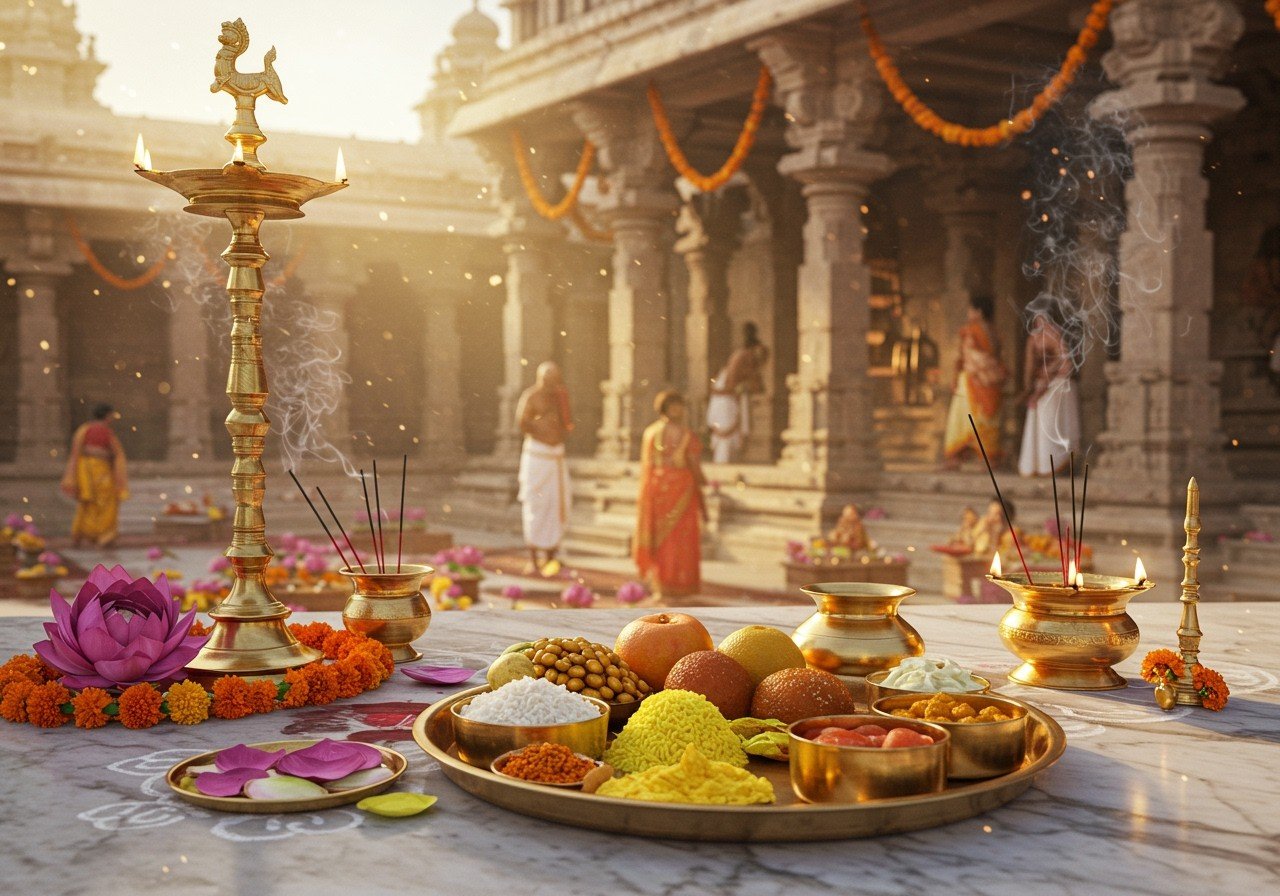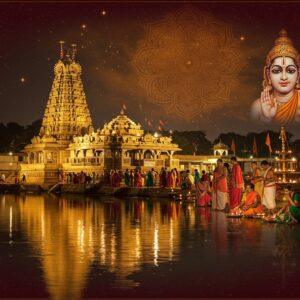
Prasada, offered with devotion and received with reverence, embodies the spiritual essence of India’s temples. More than just food, it’s a sacred offering, a symbol of divine grace, and a shared experience that binds devotees together. This blog post delves into the significance of Prasada, explores the unique traditions of prominent temples like Dharmasthala, Mantralaya, Kukke Subramanya, and Udupi, and answers frequently asked questions about this cherished practice. Let us embark on a journey to discover the heart of Prasada, where culinary tradition meets spiritual devotion.
The Significance of Prasada in Indian Temples
Prasada, in Hindu temples, symbolizes divine blessings shared among devotees. Prepared with utmost devotion and sanctity, it is first offered to the deities as Naivedya during sacred rituals. This blessed food, then distributed as Prasada, fosters unity and a sense of community amongst worshippers. It also contributes significantly to local communities and temple upkeep, forming a crucial part of the temple ecosystem. Let us learn more about these terms: Naivedya refers to the food reverently offered to the deities, while Prasada is the sanctified food graciously returned by the deities to be shared with devotees.

Understanding the Timings and Rituals
Dharmasthala: Where Hospitality Meets Devotion
Dharmasthala, a revered pilgrimage destination, is renowned for its meticulously organized Prasada rituals. Visitors here witness the deep-rooted dedication to tradition through the precise timings and the meticulous preparation of Prasada. The temple follows a sacred procedure, ensuring that every step reflects devotion and sanctity. The ‘Anna Santarpane’ ritual, a mass feeding ceremony, is a central aspect of Dharmasthala’s tradition, highlighting its commitment to selfless service by feeding thousands of devotees daily. This act of giving fosters a powerful sense of community and shared spiritual connection.
Mantralaya: Simplicity and Spiritual Nourishment
Mantralaya, a place imbued with the simple yet profound teachings of Raghavendra Swami, mirrors this essence in its Prasada offerings. Here, Prasada offers not just physical nourishment but also spiritual solace. Devotees deeply value the serene atmosphere that elevates their spiritual experience. The temple provides comprehensive information on Prasada timings, guiding visitors on their sacred journey. The preparation of Prasada at Mantralaya emphasizes purity and sanctity, ensuring every morsel is imbued with blessings.
Kukke Subramanya: Unique Customs and Efficient Distribution
Kukke Subramanya, famous for the worship of the serpent deity, offers unique Prasada customs. One notable offering is the ‘Ashlesha Bali Prasada’, particularly significant for those seeking relief from Naga Dosha. This temple is known for its efficient Prasada distribution, ensuring a seamless and fulfilling experience for all devotees. Clear timings help pilgrims plan their visit effectively, enabling them to fully participate in these sacred traditions.
Udupi: Culinary Spirituality and the Paryaya Tradition
Udupi, a town steeped in temple tradition, celebrates culinary spirituality through its unique Prasada. The temple kitchen, known as ‘Anna Brahma,’ is renowned for its meticulous preparation. It beautifully blends devotion with culinary expertise. The ‘Paryaya’ event, a cycle of religious observance that changes every two years, significantly influences the preparation and distribution of Prasada in Udupi. Specific Prasada timings reflect the temple’s structured approach to hospitality, allowing devotees to savor unique flavors and dishes that make Udupi Prasada a truly memorable experience.
How Poojn Helps You Experience the Divine
At poojn.in, we bring the sanctity of temple Prasada directly to your doorstep. We understand the deep spiritual significance of Prasada and strive to make it accessible to everyone. Explore our offerings of authentic Prasada from various revered temples, delivered with the utmost care and respect for tradition. Browse our Holy Food category to find a variety of blessed offerings. You can also enhance your spiritual practice with items from our Holy Utensils and Holy Idols collections.
For a truly immersive experience, consider our hand-printed Baran Dala and prepare your own sacred space for receiving Prasada. Complete your rituals with pure Kalash Kumkum Roli and Hawan Samagri.
Frequently Asked Questions about Prasada
What are the typical Prasada timings at Dharmasthala?
Prasada is usually served from 12:00 PM to 2:30 PM for lunch and 7:00 PM to 9:00 PM for dinner. However, timings might vary during festivals or special occasions. It’s best to check the temple’s official website or inquire directly for the most up-to-date information.
When is Prasada available at Mantralaya?
Prasada timings at Mantralaya are usually aligned with the morning and evening poojas. It is generally served from 11:00 AM to 3:00 PM and from 7:00 PM to 9:00 PM. Arriving a little early, especially during busy periods, can be helpful.
What are the Prasada timings at Kukke Subramanya?
Prasada distribution at Kukke Subramanya typically follows the main poojas. The timings are usually between 11:30 AM and 2:00 PM, and in the evening from 7:00 PM to 9:00 PM. These times may vary during special occasions, so it’s advisable to confirm beforehand.
Can you tell me about the Prasada timings in Udupi?
Prasada in Udupi is served after the completion of temple rituals. You can usually expect lunch to be available from 12:00 PM to 2:30 PM, and dinner from 7:00 PM to 9:00 PM. As always, checking the schedule during festivals or special events is recommended.
Are there any special Prasada offerings at these sacred sites?
Yes, many temples offer unique Prasada preparations during festivals and significant rituals. These special offerings often reflect local culinary traditions and incorporate seasonal ingredients, adding a unique dimension to the Prasada experience.
Is Prasada offered free of charge at these sacred sites?
Yes, in most temples in India, Prasada is offered freely to all. It is considered a divine blessing, and everyone is welcome to partake regardless of their background. This reflects the spirit of inclusivity and sharing that is central to many Indian spiritual traditions.
How is Prasada typically prepared in these temples?
Prasada is made with utmost devotion and care in the temple kitchens. Often using simple, wholesome ingredients, it’s the dedication and reverence involved in the cooking process that imbues Prasada with spiritual significance. Many believe that this process infuses the food with the temple’s divine energy, making it more than just nourishment for the body.
Embracing Tradition Through Prasada
Prasada, at these sacred sites, transcends its role as mere sustenance. It becomes a tangible connection between the divine and the devotee. Each temple, with its unique customs and timings, reveals the richness of India’s spiritual tapestry. Whether it’s the communal spirit at Dharmasthala, the serene simplicity of Mantralaya, the unique customs of Kukke Subramanya, or the culinary artistry of Udupi, every experience nourishes the soul. By understanding the importance and timing of Prasada rituals, we can deepen our immersion in these sacred traditions. With a little planning, every visit becomes a beautiful blend of spiritual fulfillment and cultural appreciation, honoring a legacy of faith, service, and community.
For more insights into Hindu traditions and rituals, you can explore related articles like Hinduism, Food, Annapoorna, and Divine Nourishment: A Sacred Relationship and Annapoorneshwari Temple, Festivals, Divine Grace, and Abundance. For those interested in exploring regional customs, we also recommend Kerala’s Sacred Foods, Sattvic Cuisine, and Temple Rituals and Guruvayur Temple: A Complete Guide to History, Significance, and Visits.


